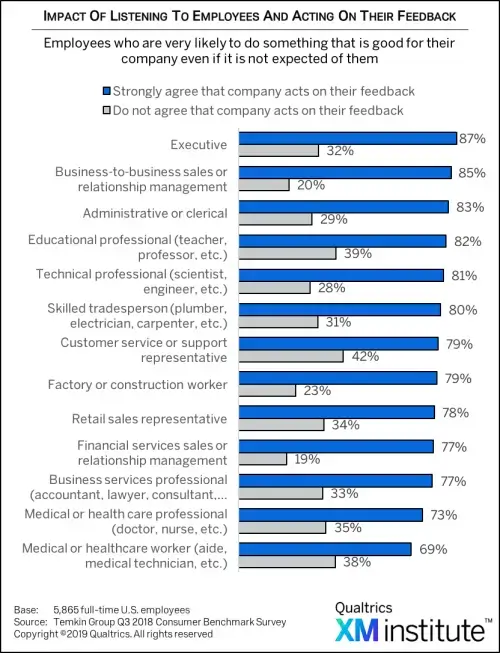What is employee feedback?
Employee feedback is a process whereby one employee, usually a supervisor or team member, gives another employee a critique of their work, performance, abilities, attitudes and skills, with the purpose of learning and growing.
Only 15% of global employees are ‘engaged’ – that is, enthusiastic about their work and contributing to their organizations in a positive way. And companies achieve better results when they:
- use employee feedback to set development goals
- make constructive feedback a consistent habit
- solicit different kinds of feedback
Feedback, whether it’s informal or formal, helps to connect employees, align teams, and accomplish goals. Exceptional feedback celebrates employee strengths and identifies opportunities to learn and grow.
Get started with our free survey software
Why is employee feedback important?
Employee feedback is one way you can make employee experiences truly transformative, through the quality of its connections and conversations.
By developing a culture of feedback and empowering employees to be great at delivering and receiving feedback, you create distinctive employee experiences.
Organizations with better employee experiences have:
- More engaged workers, which improves performance and boosts team morale. A study by Warwick University found that happier employees are around 12% more productive. Disengaged employees, on the other hand, are 10% less productive.
- A strong company culture that attracts new employees based on shared values and job satisfaction – companies that foster a strong, positive workplace culture may see up to 400% revenue growth. And 86% of job seekers will avoid applying to a company with a poor image and toxic culture.
- A decrease in employee turnover or human resource churn – one study found that there’s a 9 % lower turnover rate in companies that implement regular employee feedback to improve employee engagement.
Great employee experience starts from the day a new hire is onboarded, to the day they depart, with many experiences centered around an employee’s physical, mental, financial and spiritual health and wellbeing.

What are the types of employee feedback?
You’ll need to use both positive and negative feedback to give constructive criticism to your employees, but it’s the way in which feedback is delivered that’s the important thing.
So, what’s the best way to phrase employee feedback? Everyone loves to be praised and acknowledged for their hard work. Yet, sometimes that’s not always possible and when you have to share negative feedback, or suggest ways to change, you need to make sure you say the right things. But the outcome will always be to encourage positive behavior.
We’ll look at some positive, negative and constructive feedback examples that can start you off with providing feedback to employees.
Positive employee feedback
The big and small signals of ‘keep doing that – it’s great work’ are a necessary part of positive feedback cultures. You must be able to celebrate successes and cheer each other on when you’ve climbed a mountain (or at times even a molehill). Use positive employee feedback to build upon existing good behaviors and to reach for new heights.
Positive employee feedback examples
Positive feedback should be given for real examples of something going really well, and credited to the special characteristics or actions of a particular employee. Always explain how it was positive, as this is more valuable when employees can appreciate the impact.
Positive employee feedback examples include:
- “One of the key things I really appreciated recently was when you went the extra mile for me on our joint project. Thank you.”
- “It was a great idea to update the process in that way, because it will save us a week of work each month.”
- “I would love to get your input on this proposal, as I know you have had great success with a similar project and we could draw from your insights here as well.”
- “You really know how to build great spreadsheet models well, and that’s so helpful to have that skill on our team.”
- “You’d be well suited to working in this department, as you have very relevant experience that could be of great benefit to this year’s strategy.”
Negative employee feedback
This is the ‘stop that’ signal, pointing out the less than satisfactory moments where an employee missed the mark. It’s tricky to give negative feedback in a useful way, so take care with the delivery.
When negative feedback manages to be objective, and specific to behaviors and the impacts of those behaviors, it can help people self-correct. But when negative feedback is subjective or becomes more about the person instead of their work, it descends into unproductive criticism.
Negative employee feedback examples
With negative feedback, be very specific when describing the context, and keep your language neutral. Position the conversation starter as a chance to talk and an opportunity for the employee to respond or fill in more detail.
Negative employee feedback examples include:
- “Do you have some time this afternoon to discuss how the sales meeting presentation went this morning?”
- “I’d like to schedule a lessons-learned meeting on the recent marketing project. When can we set this up?”
- “For your onboarding team exercise, what do you think went well, and what do you think could have been improved?”
- “I’d like to speak to you about something that happened recently. On Tuesday, when you couldn’t make the delivery deadline, it led to a delay in completing the task. This had a negative effect on our client relationship and I wanted to bring it up to see how we can prevent it happening again?”
- “I wonder how we can improve on these poll results at our next group meeting?”
Constructive employee feedback
Constructive feedback could be described as a combination of ‘stop that and keep doing this’ – in the name of making improvements. As its name suggests, it’s about building, and focuses on the tasks rather than the individual. It consists of comments, advice and solutions for being better in the future.
Constructive employee feedback examples
How can you ask an employee to do something specific to achieve an end goal? Effective employee feedback may be positive or negative, but the end result is the same – you want something to happen. When you’re giving constructive feedback, make sure you’re clear on why it’s important, or what ‘success’ would look like, and explain that to the employee.
Constructive employee feedback examples include:
- “It would be great to see you share what you did in the workshops so that the wider team can learn about the key take-aways. How could we do this?”
- “I know you wanted to manage projects, and I can see you have made progress in time-management, but we need to do more in budget planning. Let’s take this opportunity to talk about how we can get you from here to there by the end of summer.”
- “Some of your recent questions can be answered using our internal resources network, and it’s a useful place to look first to see if some information is already there. Do you have what you need to access this for next time?
- “You wanted to try working on a larger project and I wanted to check how it is going? Is there something I can do to help you progress in that?”
- “I got feedback about the quote that was delivered from the client. They said it missed out details from the cost breakdown. I wanted to check in with you on what happened, and whether you’d like to get together to plan the next steps?”
Formal employee feedback
Formal employee performance management systems may present an opportunity for leaders and their direct reports to connect and discuss performance, but they tend to fall short for various reasons, especially when not used in conjunction with other informal ways of gathering and disseminating feedback.
Formal feedback includes:
- Employee performance conversations (e.g. an annual performance review)
- Formally scheduled or highly structured meetings/events
- Regular one-on-one conversations between employees and managers
- Employee surveys (e.g, employee engagement surveys, 360° or multi-rater assessments, employee lifecycle checkpoints, and training surveys)
Informal employee feedback
Employees exchange feedback on more informal settings, such as:
- Casual interpersonal interactions (e.g., water cooler chats)
- In-the-moment conversations or recaps
- Group-based settings like ‘lunch & learns’
- Peer-to-peer or employee-to-manager events
- Requested or unsolicited events
How to give employee feedback
For the best employee experience, it’s critical to make giving actionable feedback and receiving it part of your company’s DNA. But first…
What does exceptional employee feedback look like?
There are 10 qualities of exceptional feedback. At its best, effective, honest feedback is always:
- Sincere – really mean what you’re saying, and avoid cliche
- Clear – stay on topic and say what you mean
- Timely – given when it’s important and fresh
- Safe – avoids aggression and getting personal
- Grounded – based only on facts and behaviors
- Two-way – both sides have a voice in the discussion and agreeing outcomes
- Important – it identifies a goal worth working towards, and is not a ‘nit-pick’
- Solution-focused – looks futurewards and solves a problem
- Supported – make sure help and support are available
- Ongoing – it’s not an isolated event that won’t be mentioned again
How NOT to have an exceptional feedback conversation
Here’s an example of a critical feedback ‘conversation’ a manager might give before they’ve taken a moment to reflect on the above 10 qualities of exceptional feedback.
Take 1:
“Winners get into work on time. I always say you should be 15 minutes early or you’ll be lost! Your sales missed the mark last quarter and they aren’t high enough now to make up for being late. If you took your sales goals seriously and cared about your job you’d be early for work.”
“On another topic, it’s great the way you were doing those training sessions with the team last month, but I heard they didn’t cover the new updates that came out last week so what are we going to do about that?”
Let’s dissect this example using our 10 qualities of exceptional feedback:
- Sincere – Misses the mark, we edge into trite cliche territory in the first couple of statements
- Clear – not at all. There are multiple messages being given together here without any priority. Is the problem sales targets? Is it employee lateness? Is there some new expectation that employees should be earlier than their contracted hours? Who knows?
- Timely – we hear some reference to previous sales results that can’t be changed, and this distracts from the desired change. There are other comments about things that happened a month ago that also mix the feedback message
- Safe – it includes personal judgments that could make the recipient feel unsafe. Statements in this feedback seem to be connecting punctuality with ability. The person on the other side of this feedback may feel like their character is being insulted.
- Grounded – comments that the person receiving the feedback isn’t taking things ‘seriously’ are not based on observable behaviors. Stick to behavioral examples and changes when giving feedback.
- Two-way – it’s not. The only opportunity for dialogue is at the end of the feedback
- Important: muddled – Is an early arrival to work the desired change? Or are sales goals dependent upon timekeeping? Or is this a telling-off for last quarter’s sales? This is vague feedback.
- Solution-focused – This accentuates the negative without a solution. There are ‘stop’ signals here in terms of lateness, but no ‘go’ signals for new behaviors around meeting sales targets
- Supported – Not a single piece of support is given to help make a behavioral change
- Ongoing – it moves onto another topic not allowing for agreements about what to do next
How to have an exceptional feedback conversation
Now, working with our 10 qualities of exceptional feedback, here’s how to adjust the conversation:
Take 2:
“I’d like to look at your sales goals with you and identify ways that we can get you some support to hit them this quarter. What are your initial thoughts?”
“I see you booking a lot of new introductory calls this week, but I don’t see the follow-up on questions that come from those calls happening.”
“One of the habits that someone shared with me that helped me make sure I cover my follow-ups is to start each day updating my to-do list from the previous day’s calls – to achieve that for myself I’ve had to adjust my schedule come in earlier than I used to – would that or something else work for you?”
“Are there barriers that you are facing? Let’s see if we can clear the way or adjust other priorities. For some of the barriers, we may only be able to acknowledge that they’re making things harder, but for others, we may be able to remove them.”
“I’m always here if you want me as a sounding board for ideas or advice. What are some of the other resources you can tap into or mentors you might ask for guidance? My goal is to enable you and the rest of the team to achieve your goals. Let’s recap what we’ll both do next. We have until the end of the quarter to meet this target and we get updates on our numbers twice a month – let’s check-in before those next numbers come out and update our plans.”
As you can see, this is a much better way of providing positive feedback.
Top tips for receiving feedback yourself
It’s essential to ask for feedback from employees around you, to help you track your performance on a task, or help you recognize upcoming risks and unhelpful obstacles. It’s normal – and desirable – to get feedback at every stage of your work life, so embrace the learning points by listening and taking in the information.
Asking for feedback
You can approach other team members to request feedback by email, in a survey, or in person, though this can depend if you want to create a formal or informal environment. When you send your request, clearly state: why you’re asking and what you will do with the results, so employees can understand why this is important. This will also increase the likelihood of responses coming back.
Some examples you could use:
“As we enter stage 2 of the project, I want to make sure I’m contributing the right information to team discussions, so that we can act with confidence on the findings of my research. Can you provide feedback about what you thought of my output from stage 1?”
“I’m trying to learn more about how this business model works, so I can share this with my wider team. Can you tell me how I could improve my knowledge here?!
“Please find attached the latest version of the corporate slides, that have recently been updated to the newest style. Can you please review this and let me know if there’s anything that needs amending?”
Listening to feedback
Feedback is a gift. When employee feedback is directed at you, take the information with a positive attitude that they are insights to help you learn. These techniques will keep you focused:
- Use active listening – Pay attention to the language cues – verbal and non-verbal – coming from the speaker, to get a full picture of what’s been said.
- Summarize to retain the information – At the end, feed back the key points to the speaker to make sure you have understood the information and what is being asked of you.
- Confirm your intention – To round off the feedback, you can respond to the speaker by first thanking them for their feedback. You could share what you’ve learned from the conversation and how you will act as a result in the future.
- Act upon the insights you’ve gained, and follow-up with the speaker if necessary.
How can managers improve employee satisfaction with the feedback process?
1. Make no assumptions
We don’t always know the full context of what others are experiencing. They may present like swans, calm on the surface, but with legs paddling away frantically underneath. Assumptions about other people can lead to overreactions or counterproductive behaviors.
Balance understanding context and offering people a chance to ‘explain their side’, while focusing on agreeing changes for future projects.
2. Treat others how you want to be treated yourself
As your feedback discussions grow, along with employee confidence, open the dialogue and find out how employees like to give and receive feedback and what works for them.
Using employee input, adapt your process to treat others how they ask to be treated. Strive to meet people where they are and adapt your style.
3. Focus on solutions
You can’t change past problematic behavior. Instead, stay focused on the future, each employee’s good qualities, and on solving issues to deliver sound business outcomes. The focus should always be on a positive feedback culture that helps you achieve your goals.
Here are our 5 tips to help you encourage positive employee experiences, provide positive feedback and boost your company performance as a result:
1. Take a look at your current feedback mechanisms
Take stock of your existing performance review processes and formal systems for feedback. Do you use surveys? Focus groups? One to one meetings?
Consider the experience surveys (another formal system) that exist at your workplace (onboarding, post-training, engagement, or exit) and their frequency.
Once you understand the best feedback channel and how frequently that feedback will occur, share it with your team.
Help your team with providing employee feedback, and decide how the data is used and for what purposes (e.g., performance-based and developmental mechanisms are different and serve different purposes).
Identify informal ways of giving team feedback. Team feedback can be given through activities like ‘lunch and learns’, project team meetings, instant messaging systems, team bulletin boards, after-action reviews, etc. Generate a list that incorporates your ways of working together as a team.
Technology should play a major part. Using collaboration tools such as Slack and Asana makes leaving team feedback easy. These platforms actively encourage celebrating successes or highlighting positive team action, with fun features built in to create an informal atmosphere online for the entire team that delivers meaningful feedback.
2. Let your teams own their employee feedback
Foster interactions where employees and teams can set their own goals for improvement and align your feedback. Spend some time asking questions such as:
- Do you feel sufficiently psychologically safe when you’re giving constructive feedback?
- Are we asking for feedback enough? Or are we asking too often?
- What are some ways you’ve brought solutions to feedback conversations you’ve had?
- What are our team’s standards for working together with each other and with other teams, customers/clients, or vendors?
- What ways have we given and received feedback in the past that worked for us?
3. Make every day a feedback culture day
Interact regularly, for example, when:
- Kicking off new projects or workstreams together
- Weekly or monthly one-on-one meetings
- Goal setting and development conversations
- Conversations around what you’ve all agreed to work on together
Reinforce with your team that the tasks they’re working on, and the skills they’re using are learned through study, practice, and repetition.
Both informal feedback and formal feedback mechanisms ensure that every person can learn from each other. Remind employees that what seems effortless for someone else may be a skill they’ve decided to work on in the past. Think of suitable opportunities when you can open the floor to colleagues to let them share their experiences with each other.
Bring other resources into play. Employee feedback is not only confined to your team and yourself. You can ask for support from other departments and resources from around the company. These can include HR, training & learning resources, other mentors or appropriate peers.
Remember – consistency is key. You can have a huge impact on your team’s feedback culture by committing to one or two changes, enacting feedback follow-ups, making employee accountability clear, and working together to consistently follow these practices.
4. Be an employee feedback role model
Be sure to share your own feedback preferences with your team. Sometimes it can be tricky for employees to find a good time to share feedback. Help them approach you by sharing your preferred method of giving feedback, and what times would be best for them to contact you.
It’s also important that you ask for feedback about yourself and your management style.
Make time to intentionally ask others for constructive feedback on how you’re doing and make it a safe space for effective feedback. Try out various methods (e.g. an honesty online suggestion box or a call for ideas at monthly meetings) until everyone gets used to giving and receiving feedback.
Aim to define goals that include both a big-picture viewpoint and some specific and measurable things that you want to be achieved. Encourage others to put those expectations into their own words for ownership and clarity.
Remind your team (and yourself) that it is OK to be imperfect – in fact, “perfect is the enemy of the good”. You might have worked on similar professional growth areas as your team members. Sharing your learning curve can help make that journey feel possible for others. They may also benefit from your advice on how to make their journey easier.
People are surprising. Expect to be surprised by team members’ abilities to exceed your expectations. Thoughtful, consistent, effective employee feedback can improve the work experience and the quality of output for everyone on the team and build resilience.
5. Create a company culture of action – not just feedback
The most important takeaway is that laying a foundation for happier employees, more productive discussions and innovative solution-building takes buy-in from everyone in your organization. Feedback needs to run through the DNA of the whole company.
Company culture dictates the workplace environment. Create an opportunity to bring together high-level leadership support and formal strategy planning to make employee experience culture a long-term goal.
Feedback systems will continue to evolve as we digitally transform into the workplaces of tomorrow. Workplaces are now remote and people are spread across different time-zones. Invest in a rapid, smart feedback system to become agile and responsive to workplace changes as they happen.
The culture of action also works both ways. When you encourage a culture that sets out organizational values and beliefs for greater inclusivity and open discussion, you’ll get greater contribution and involvement from your employees.
In tech, we often hire for culture fit. Instead, we should hire for culture contribution.
– Judith Williams, Global Head of People Sustainability & Chief Diversity & Inclusion Officer at SAP
Three examples of effective employee feedback tools we use at Qualtrics
Qualtrics is the home of employee feedback solutions. And at our core has always been surveys.
But as it becomes harder to sift through the noise and get real signals on how our people feel — in the moments that matter — we have to move beyond surveys to real-time, in-the-moment feedback to get a more holistic view of employee experience.
And as we start to capture this kind of data at scale, across channels, and at every stage of experience, we can empower managers, people leaders and CHROs to make the right decisions and drive business outcomes.
Our platform is designed to do all of that. We call it XM for Experience — a purpose-built suite of solutions that address the entire employee experience lifecycle in a way that no other platform can.
It ensures that you can build diverse, high-performance teams, improve frontline manager and individual effectiveness, and make timely decisions across the entire EX continuum.
Here are just a few of the solutions:
1. Qualtrics EX25
Employee engagement, as a single metric, is no longer sufficient. It only provides a slice of engagement at a specific moment in time.
To provide a more holistic view of employee engagement — and overall experience — we developed EX25, an industry-leading, all-encompassing approach to measuring and optimizing the employee experience.
EX25 leverages years of client research and global validation studies to provide the standard for understanding and acting on employee experiences.
It includes:
- A program design guide that helps employers pulse their employees at the right cadence for them, so they can stay in tune with employees throughout the year while avoiding survey fatigue
- A comprehensive library of scientifically validated items, including 5 KPIs to track employee experience and 25 drivers, critical topics that impact KPIs
- Dashboard templates with analysis of employee feedback to help managers and leaders understand and address the top drivers of employee engagement across their teams
- Benchmarks that illustrate how a company’s employee experience compares to others in the same industry
- Expert-designed action guidance that helps managers to meaningfully improve on each experience driver.
With EX25, you can holistically understand employee experience and where to focus to drive impact, without adding more complexity to your employee listening program.
It goes beyond engagement to truly understand how your people feel at every moment.
2. Manager Assist
75% of people who leave their jobs do so because of their manager, and it costs an organization 6 to 9 months of an employee’s salary to replace them.
Manager Assist gives managers automated, real-time insights about team sentiment all in one place, and helps them take action with empathy and speed. It helps managers understand where and why employees are frustrated so they can quickly intervene to keep their teams working efficiently and effectively while also avoiding costly employee attrition.
3. Employee Listening
There’s simply too much data across different mediums to really get a clear picture of how employees feel. You need an employee listening tool to give color and nuance to employee feedback at scale and across channels, so that you can understand how people feel in the moment.
Discover XM on our Experience Management Platform™ is a suite of tools that help you discover insights in unstructured data, whatever platform it’s shared on, and give you actionable insights into experience gaps.This can help you to understand what employees are saying about your company, whatever platform they’re saying it on. From the contact center to social media to online reviews—and everywhere in between.
With omni-channel listening, you’ll hear every voice, including the quiet ones. The software combs through every platform to understand how employees feel about your company. Using natural language processing, conversational intelligence and analytics software knows the difference in the subtleties of human language (even emojis), to reveal the emotion, intent, and effort of each interaction.



